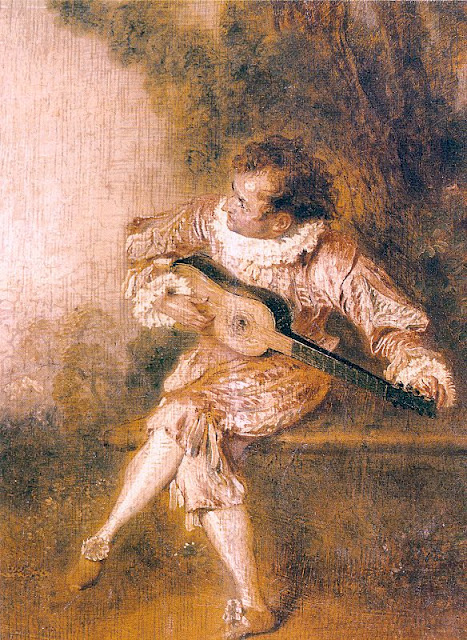Antoine Watteau(1684-1721)
Jean-Antoine Watteau / French pronunciation: October 10, 1684 – July 18, 1721) was a French painter whose brief career spurred the revival of interest in colour and movement (in the tradition of Correggio and Rubens). He revitalized the waning Baroque style, and indeed moved it to the less severe, more naturalistic, less formally classical Rococo.
Watteau is credited with inventing the genre of fêtes galantes: scenes of bucolic and idyllic charm, suffused with an air of theatricality. Some of his best known subjects were drawn from the world of Italian comedy and ballet.
Watteau was born in the town of Valenciennes, which had recently passed from the Spanish Netherlands to France. His father was a master tiler. Showing an early interest in painting, he was apprenticed to Jacques-Albert Gérin, a local painter. Having little to learn from Gérin, Watteau left for Paris in about 1702. There he found employment in a workshop at Pont Notre-Dame, making copies of popular genre paintings in the Flemish and Dutch tradition; it was in that period that he developed his characteristic sketchlike technique.
In 1703 he was employed as an assistant by the painter Claude Gillot, whose work represented a reaction against the turgid official art of Louis XIV's reign. In Gillot's studio Watteau became acquainted with the characters of the commedia dell'arte (its actors had been expelled from France several years before), a favorite subject of Gillot's that would become one of Watteau's lifelong passions. Afterward he moved to the workshop of Claude Audran III, an interior decorator, under whose influence he began to make drawings admired for their consummate elegance. Audran was the curator of the Palais du Luxembourg, where Watteau was able to see the magnificent series of canvases painted by Peter Paul Rubens for Queen Marie de Medici. The Flemish painter would become one of his major influences, together with the Venetian masters he would later study in the collection of his patron and friend, the banker Pierre Crozat.
















































Tidak ada komentar:
Posting Komentar